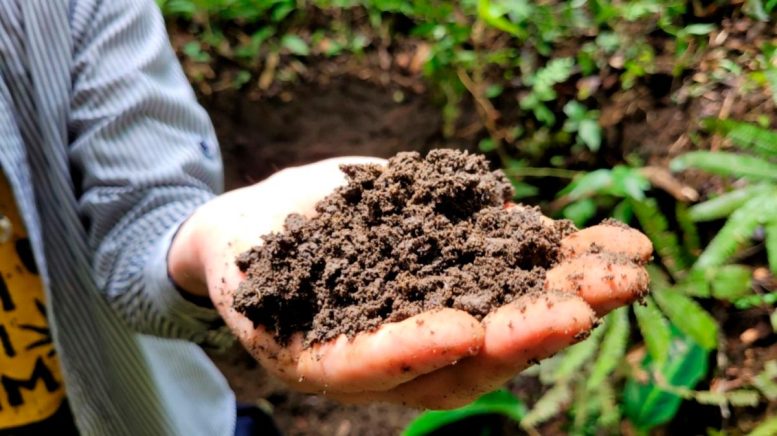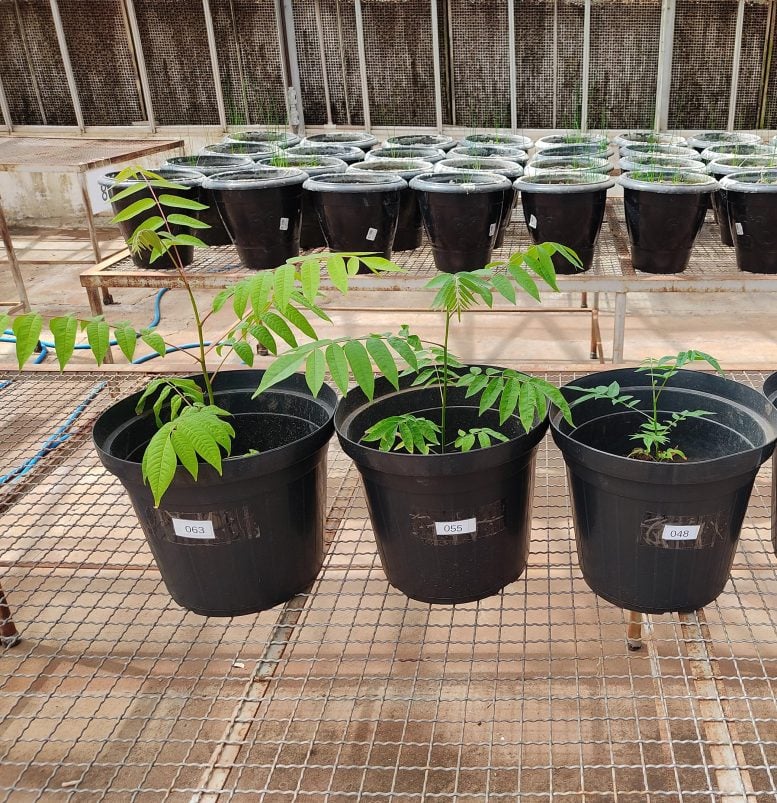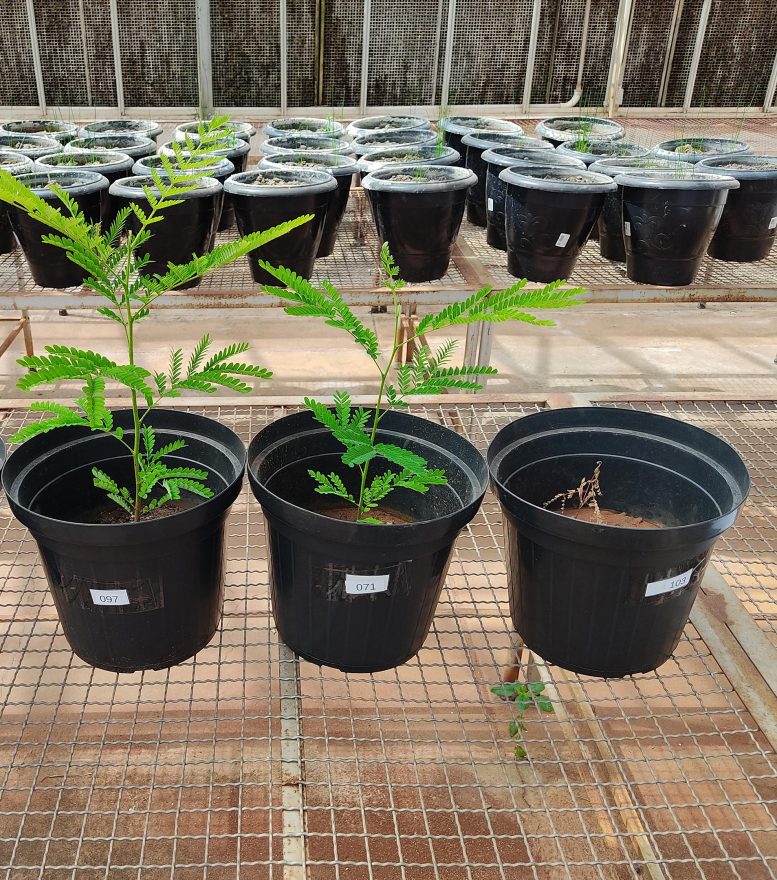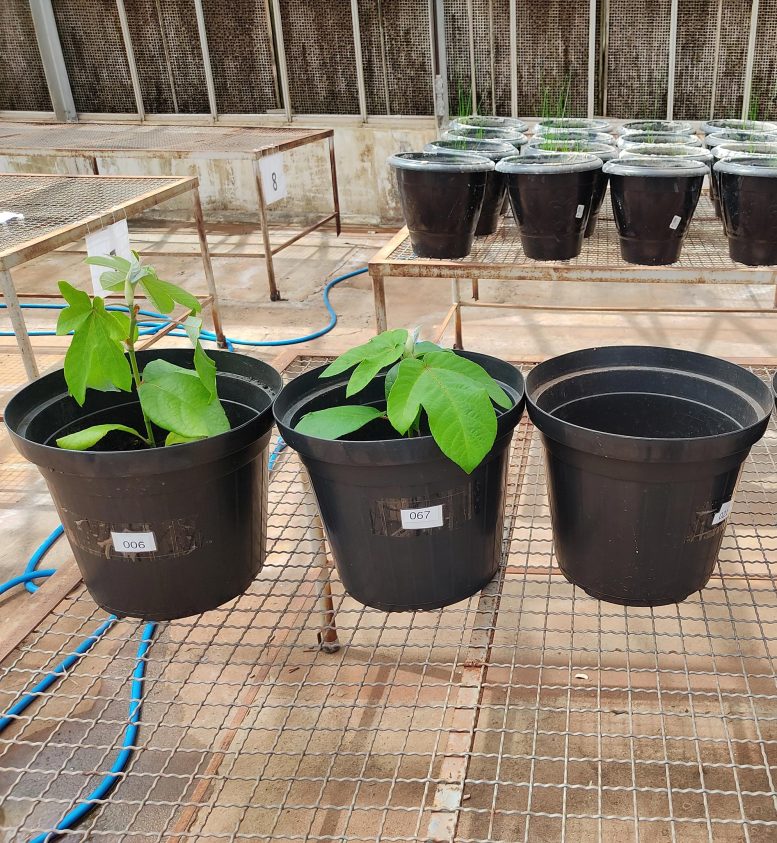Brazilian scientists analyzed the typical soil composition resulting from native management with the aim of developing biotech applications for more effective restoration of degraded areas. Credit: Luís Felipe Zagatto/CENA-USP
Research indicates that Amazon dark earth (ADE) promotes tree growth by as much as sixfold. The study demonstrated that tree seedlings grown in ADE-enriched soils saw exponential growth compared to control soils.
A type of soil called terra preta da Amazônia, or Amazon dark earth (ADE), promotes faster growth of trees and enhances their development in qualitative terms, according to an article published in the journal Frontiers in Soil Science.
“ADE is rich in nutrients and supports communities of microorganisms that help plants grow, among other things. Native people of the Amazon have used ADE to grow food for centuries and don’t need fertilizer for plants,” said Luís Felipe Guandalin Zagatto, a master’s student at the University of São Paulo’s Center for Nuclear Energy in Agriculture (CENA-USP) in Piracicaba, Brazil, and one of the authors of the article.
Final vases for Cedrela fissilis show differences in growth depending on soil. From left to right: 100% ADE, 20% ADE, Control soil. Credit: Luís Felipe Guandalin Zagatto
Research Findings
The researchers found the microbiota (bacteria, archaea, fungi, and other microorganisms) in ADE to be highly beneficial to plant growth. The addition of ADE to the soil boosted the growth of the three tree species they analyzed. Seedlings of Brazilian cedarwood (Cedrela fissilis) and Yellow poinciana (Peltophorum dubium) grew to between twice and five times normal height in soil with 20% ADE, and three to six times with 100% ADE, compared with growth in control soil. Ambay pumpwood (Cecropia pachystachya) did not grow at all in control soil (soil without ADE) but flourished in 100% ADE.
The dry mass of Brachiaria forage grass increased more than threefold in soil with 20% ADE compared with control soil, and by more than a factor of eight in 100% ADE.
Final vases for Peltophorum dubium show differences in growth depending on soil. From left to right: 100% ADE, 20% ADE, Control soil. Credit: Luís Felipe Guandalin Zagatto
“The bacteria in ADE convert certain molecules in the soil into substances that can be absorbed by plants. Using a very rudimentary analogy, you could say the bacteria act as miniature ‘chefs’ by transforming substances that can’t be ‘digested’ by plants into substances they can profitably metabolize,” said Anderson Santos de Freitas, first author of the article. He is a PhD candidate at CENA-USP and co-author of the podcast Biotec em Pauta.
ADE contained more nutrients than the control soil: 30 times more phosphorus, for example, and three to five times more of each of the other nutrients measured, except manganese. It also had a higher pH.
Final vases for Cecropia pachystachya show differences in growth depending on soil. From left to right: 100% ADE, 20% ADE, Control soil. Credit: Luís Felipe Guandalin Zagatto
Experimental Procedure
Zagatto and colleagues collected samples of ADE at the Caldeirão Experimental Field in Amazonas state. The control soil came from experimental croplands maintained by Luiz de Queiroz College of Agriculture (ESALQ-USP) in Piracicaba, São Paulo state.
They filled 36 four-liter pots with 3 kg (6.6 pounds) of soil each and placed them in a greenhouse with an average temperature of 34 °C (93 °F), anticipating the impact of global warming, as temperatures in the Amazon currently range from 22 °C to 28 °C (72 °F to (82 °F).
A third of the pots were filled with control soil, a third with a 4:1 mixture of control soil and ADE, and a third with 100% ADE. To mimic pasture, they planted seeds of Brachiaria forage grass (Urochloa brizantha) in every pot, leaving them to sprout for 60 days. They then cut the grass but left the roots, simulating restoration of degraded pasture by sowing seeds of the three tree species.
Biotech Implications
The group does not propose the use of ADE as such, Zagatto explained, since it is a finite resource and well protected. The point of their research is to analyze ADE’s chemical properties (nutrients, organic matter, and pH) as well as the enzyme activity and other biological and biochemical aspects that benefit plants.
“We need to understand exactly which microorganisms are responsible for these effects, and how we can use them without requiring ADE as such. We can then try, for example, to replicate these characteristics by means of biotech developments. This study was a first step in that direction,” he said.
Deforestation is a serious problem for Brazil, and not only in the Amazon. There are several reasons, such as replacement of forest by pasture or cropland, for example. It is increasingly important to find ways to restore these areas rapidly, so that the forest grows back and ecosystem services resume, with all the benefits they give the environment and human populations, including climate and air quality regulation, as well as carbon storage in the soil.
“In the study, we set out to evaluate a possible driver of improvement for tropical forest ecological restoration projects, more specifically in the Amazon, so that in future these areas can return as near as possible to their original state,” Zagarro said. “We believe these results are promising and show that using the characteristics of ADE in seedling production or even directly in the field can be a way to accelerate tropical forest ecological restoration.”
For more on this research, see How Ancient Soil Can Boost Forest Restoration Across the Globe.
Reference: “Amazonian dark earths enhance the establishment of tree species in forest ecological restoration” by Anderson Santos de Freitas, Luís Felipe Guandalin Zagatto, Gabriel Silvestre Rocha, Franciele Muchalak, Solange dos Santos Silva, Aleksander Westphal Muniz, Rogério Eiji Hanada and Siu Mui Tsai, 5 May 2023, Frontiers in Soil Science.
DOI: 10.3389/fsoil.2023.1161627
The findings reported in the article resulted from studies supported by FAPESP (projects 20/08927-0, 18/19000-4 and 14/50320-4) under the aegis of its Biodiversity, Characterization, Conservation, Restoration and Sustainable Use Program (BIOTA).
>>> Read full article>>>
Copyright for syndicated content belongs to the linked Source : SciTechDaily – https://scitechdaily.com/amazons-dark-secret-the-soil-that-supercharges-tree-growth/














![[News] Japan Develops 10nm Nanoimprint Technology, with Potential to Tackle EUV Bottleneck – TrendForce](https://earth-news.info/wp-content/uploads/2025/12/329851-news-japan-develops-10nm-nanoimprint-technology-with-potential-to-tackle-euv-bottleneck-trendforce-360x180.jpg)




















